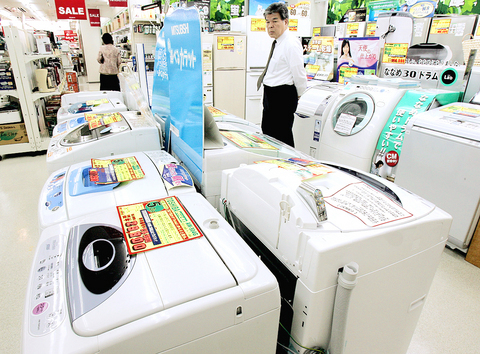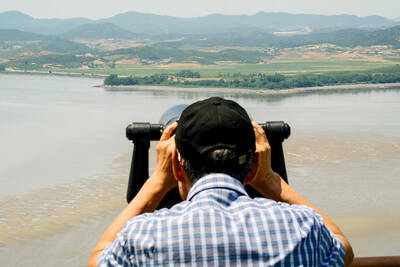When it comes to airing our dirty laundry, we wonder why the laundry services we pay for always do a better job than we can at home. With the help of "professional" washing machines, laundry services simply do a cleaner job. Professional laundry services count on front-loading
washers to impress the customers, while most Taiwanese households still stick with the conventional top-loading washers to get the dirty job done.
In the past, front-loading washers in Taiwan were so prohibitively expensive that only professional cleaners or laundromats could afford them. In recent years, to satisfy Asian customers, washing-machine manufacturers have been doing their best to develop inexpensive front-loaders that can still get clothes cleaner, save more water and electricity and use less detergent than top-loaders.

Moreover, the trendy aspect of nano-technology used in the latest washers is sure to please tech-savvy users.
More importantly, the overall price of a front-loader has now plunged to somewhere between NT$25,000 and NT$30,000, depending on loading capacity.
Huang Shih-liang (

PHOTO: AP
Taipei times: What is the front-loading washing machine?
Huang Shih-liang: This type of efficient washing machine has a door in the front instead of an opening on top of the machine. Clothes are placed in a horizontally-oriented stainless-steel drum instead of a conventional tub with central agitator.
TT: In terms of the operation, what is the difference between the the top-loading washer and the front-loading washer?
HSL: The top-loading washer is built on a vertical axis and uses more water to fully immerse clothes in the tub and scrub them clean with agitation. The front-loading washing machine, however, is built on a horizontal-axis and does not have an agitator that is used in a top-loading vertical-axis washing machine. With a more advanced structure, the front-loader generally uses less water, electricity and detergent.
TT: Why does the front-loading washing machine use less water and save more money?
HSL: A front-loader with the loading capacity of up to 10kg will consume 70 liters to100l of water in one load of laundry. Meanwhile, a top-loader with the same capacity will take 180l to 240l liters of water. Clearly a front-loader reduces water consumption by at least half and the amount of detergent used is also reduced in the process.
TT: If equipped with the same loading capacity, why does the tumble of the front-loader look smaller than that of the top-loader?
HSL: In a front-loader, the clothes are lifted and dropped into a more concentrated solution of water and detergent. The reversing tumble action kneads the water and detergent deeply into the fabric fibers. Since the washer never fills above the bottom of the washer door, much less water is used and less space is needed.
TT: Some front-loaders use warm water and nano-technology to do the laundry. Why do they do this?
HSL: Some front-loaders can automatically heat water up to 40?C to 60?C, which further reduces detergent use and helps tackle smelly clothing. Some manufacturers have even incorporated what they call "silver nano-technology" to enhance the anti-bacteria function. This is even more effective than the use of warm water for washing.
TT: What else do we have to keep in mind while using a front-loader?
HSL: First, the front-loader usually uses the foam produced by the detergent to gauge the cleaning process. Putting excessive detergent in the wash may cause front-loaders to wash clothing for excessive periods of time.
Second, as elderly or people with restricted movement sometimes find it difficult to bend to fill front-loaders, new designs are now emerging in which the performance advantages of front-loaders are coupled with the convenience of a top-loading design.
-- Translated by Daniel Cheng

In the next few months tough decisions will need to be made by the Taiwan People’s Party (TPP) and their pan-blue allies in the Chinese Nationalist Party (KMT). It will reveal just how real their alliance is with actual power at stake. Party founder Ko Wen-je (柯文哲) faced these tough questions, which we explored in part one of this series, “Ko Wen-je, the KMT’s prickly ally,” (Aug. 16, page 12). Ko was open to cooperation, but on his terms. He openly fretted about being “swallowed up” by the KMT, and was keenly aware of the experience of the People’s First Party

Aug. 25 to Aug. 31 Although Mr. Lin (林) had been married to his Japanese wife for a decade, their union was never legally recognized — and even their daughter was officially deemed illegitimate. During the first half of Japanese rule in Taiwan, only marriages between Japanese men and Taiwanese women were valid, unless the Taiwanese husband formally joined a Japanese household. In 1920, Lin took his frustrations directly to the Ministry of Home Affairs: “Since Japan took possession of Taiwan, we have obeyed the government’s directives and committed ourselves to breaking old Qing-era customs. Yet ... our marriages remain unrecognized,

Not long into Mistress Dispeller, a quietly jaw-dropping new documentary from director Elizabeth Lo, the film’s eponymous character lays out her thesis for ridding marriages of troublesome extra lovers. “When someone becomes a mistress,” she says, “it’s because they feel they don’t deserve complete love. She’s the one who needs our help the most.” Wang Zhenxi, a mistress dispeller based in north-central China’s Henan province, is one of a growing number of self-styled professionals who earn a living by intervening in people’s marriages — to “dispel” them of intruders. “I was looking for a love story set in China,” says Lo,

Standing on top of a small mountain, Kim Seung-ho gazes out over an expanse of paddy fields glowing in their autumn gold, the ripening grains swaying gently in the wind. In the distance, North Korea stretches beyond the horizon. “It’s so peaceful,” says the director of the DMZ Ecology Research Institute. “Over there, it used to be an artillery range, but since they stopped firing, the nature has become so beautiful.” The land before him is the demilitarized zone, or DMZ, a strip of land that runs across the Korean peninsula, dividing North and South Korea roughly along the 38th parallel north. This